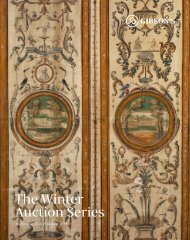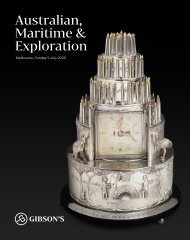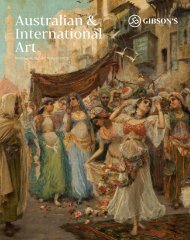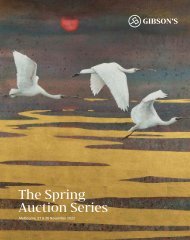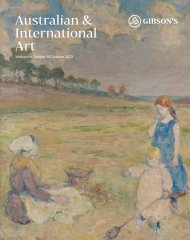The Summer Art Collection
Create successful ePaper yourself
Turn your PDF publications into a flip-book with our unique Google optimized e-Paper software.
5<br />
HARRY ROYALL<br />
How I Won the V.C. at Massines, Private John Carroll<br />
oil on paper<br />
signed lower left: Hy Royall<br />
bears unique inscription written by Private John<br />
Carroll: How I won the VC at Massines Pte J Carroll<br />
VC, captured a machine gun & killing four Germans &<br />
saving a mate from being killed by one of Germans<br />
bears label verso: 24 Carroll V.C. How<br />
I won the V.V. at Messines<br />
76 x 54cm<br />
PROVENANCE<br />
Aust. <strong>Art</strong> Auctions, Australian & International<br />
Paintings, Sydney, 1July 2002, Lot 103<br />
NOTE<br />
<strong>The</strong> painting is remarkably accurate. Charles Bean<br />
wrote "the only point at which real resistance has been<br />
felt was on the right where 33 Battalion had moved<br />
forward on the extreme right flank". <strong>The</strong> painting depicts<br />
Carroll in action with the last of the explosions shown<br />
to the left of his position where the Germans offered<br />
little resistance following the great explosions.<br />
$10,000–20,000<br />
Jack Carroll was born in Brisbane but grew up in<br />
Western Australia and worked around Kalgoorlie<br />
and nearby Karrawang. In 1916 he joined the AIF's<br />
44th Battalion, but soon transferred to the 33rd.<br />
Messines was the battalion's first big action.<br />
Over the period of 7-10 June, during the battle at St Yves<br />
(near Messines), Carroll was outstanding: he rushed an<br />
enemy trench and killed four Germans; assisted a soldier in<br />
distress and killed another German; attacked a machine-gun<br />
team, killing three men and capturing the gun; then extracted<br />
comrades buried in a shell hole while under heavy fire. His<br />
citation declared: "his magnificent example of gallantry<br />
and devotion to duty inspired all ranks in his battalion".<br />
Carroll was a casual and happy-go-lucky man, known by his<br />
mates as "the wild Irishman". He was wounded a month later<br />
and again, severely this time, on 12 October 1917. Returned<br />
to Australia, he resumed work as a labourer and railwayman.<br />
In 1927 he had his foot amputated in a work accident.<br />
John Carroll died on 4 October 1971, at the age of 80,<br />
and was buried at Karrakatta Cemetery in Perth with<br />
full military honours. His Victoria Cross is displayed<br />
at the Australian War Memorial in Canberra.<br />
8









